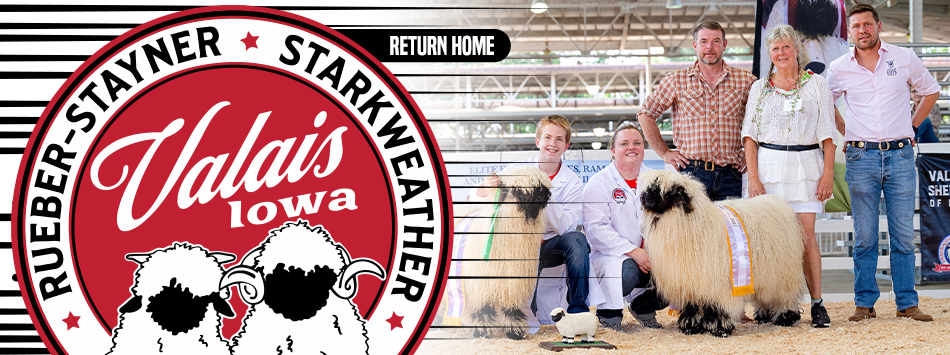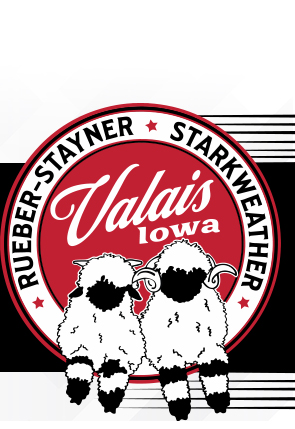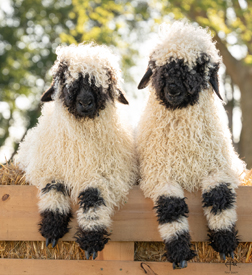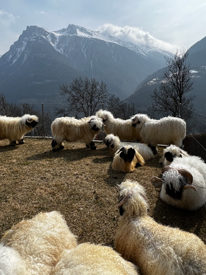VALAIS BLACKNOSE
Long white spiral curls on a black face, long curly fleece with black knees and feet spots. Valais Blacknose Sheep are known as “The Cutest Sheep In The World”! Their appearance grabs your attention and their personality makes you fall in love!
Bet your first words were, “Those are adorable!” They look like stuffed animals with their fluffy curly white wool and eye-catching bold black markings on their face & nose, ears, knees, hocks and feet. The Valais have an easygoing, gentle, curious, people-friendly disposition with behavior more dog-like than sheep. The Valais are popular pasture pets, as well as breeding stock.
The Valais Blacknose are a new breed to the United States. Prior to 2020, there were no purebred Valais Blacknose sheep in the US. The process to produce “domestic purebreds” in the United States is through the Breed Up Program. The first purebred frozen embryos were imported into the US in 2020.
Valais Blacknose Sheep are a mountain breed originating from the Valais region of Switzerland in the Swiss Alps, in the 1400s. Valais Blacknose are a wool and meat breed. These beauties grow 12 inches of wool per year! Shearing them twice per year is recommended. Switzerland started AND STOPPED exportation of Valais Blacknose live animals in 2013-2014.
History
 |
The Blacknose sheep originates from the Valais canton of Switzerland. Native to the Upper Valais region, the Blacknose graze in the Alps in the summer months June-September. Though housed through the winter, the Blacknose is a sturdy breed which is well adapted to the harsh conditions of the mountains, which can be endured even in the summer months. |
There is evidence that the Blacknose has existed since the 15th century, however they have changed greatly in appearance over the years and once resembled the likes of a Scottish Blackface. Over time, characteristics have evolved to the majestic sheep we see today.
In Valais, it is reported that there are in the region of 13,700 registered Blacknose sheep in the breed flock book. As a large, relatively slow-maturing breed, Valais Blacknose ewes in Switzerland are usually not bred until they are over 12 months of age, normally lambing for the first time at 18-24 months old. They are also nonseasonal breeders, with a reproduction rate of 1.6 lambs per year, however it is recommended to breed naturally once a year.
|
Breed Standard
Breed Standards Guide
Typical Breed Characteristics:
The characteristics of the Blacknose sheep fall into three areas: General Appearance, Conformation and Wool.
Giving the Blacknose sheep its name, you will find the sheep to have a black nose which extends up to the center of the head connecting and encompassing the black surrounding the eyes.
The ears are black to the point where they meet the head.
Knees and hocks have black spots and the hoof/ankle area is black creating the impression of black boots.
Ewes have a black tail spot, rams do not.
Horns are helical or spiral and grow outward from the head in both ewes and rams.
The wool is an important characteristic and the whole body, head and legs is evenly well-covered, exhibiting the sheep’s robust frame.
1. Appearance
Color Features:
* Black nose to the center of the head
* Black encompassing the eye area connecting with the black of the nose, no gap is permitted
* Black ears – black should meet the white of the head
* Black hooves and ankle area (‘black socks’)
* Black spots on knees and hocks (spots can be non-symmetrical)
* Females are to have a black tail spot. There must be a finger-width gap of white on the tail.
* For females missing a marking feature i.e. knee spot, a point deduction might be made depending on overall conformation and wool.
* Males must not have a tail spot
* Male scrotum may be black and the black may extend to the lower belly, but must not spread further upwards towards the tail or beyond the naval area.
Spitti:
On occasion a purebred Valais Blacknose may produce offspring marked in reverse color/markings which are referred to as ‘Spitti’ (a name adopted in the UK from Swiss Blacknose breeders). However, in Switzerland the ‘Spitti’ may be referred to by different names in the varying villages and areas of Valais. Spitti rams should be castrated and not used for breeding purposes. |
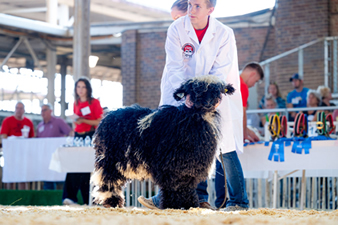 |
Head & Neck:
* Well proportioned, compact head
* Roman nose, wide mouth, broad forehead
* Pronounced, regal head shape in rams. Mature rams often develop protuberance behind horn base
* Short, straight well-muscled neck
Horns:
* Spiral outward from head, horizontally away from cheeks (You should always be able to fit a flat hand comfortably between the horn and cheek)
* Black stripes in the horns are acceptable
Chest, Shoulder & Withers:
* Wide, deep, chest area
* Shoulders line naturally with neck and chest
* Well-spaced, wide withers
* Rib cage curvature is well proportioned and rounded |
Back & Loin:
* Long, straight top line
* Wide back and loin
Pelvis, Abdomen & Hindquarters:
* Medium sized belly with small belly hollows/pits (paralumbar fossa)
* Wide and medium-length pelvis
* Well-muscled hindquarters
Withers (from two years):
* Female: 28.35 - 31 inches
* Male: 29.5 – 32.68 inches
Weight (over two years):
* Female: 150-200 pounds
* Male: 175-275 pounds |
2. Conformation
Limbs:
* Strong, sure footed
* Solid hoof deportment
* Legs are not bandy/bow legged
* Legs are not knock-kneed |
Foundations:
* Slight hock angulation
* Short, strong pasterns (45-degree angle)
* Solid bone structure
* Joints should be straight and sound |
Gait:
* Spacious, sure footed and wide legged
* Doesn’t sway or waver
* Even and stable movement
* Mobile with ease |
3. Wool
* Fleece in lambs is soft to touch but becomes coarser as the sheep matures (The Swiss grade approximately equates to 28-38 microns depending on age and gender. Fiber diameter generally finest in lambs and coarsest in adult males)
* Staple length is ~4 inches based on 6 months growth (Recommended to be shorn twice a year. Fleece weight when shorn approx. – Lambs 2.2-3.1 lbs / Ewes 5.5-6.61 lbs / Rams 5.5-6.61 lbs – Based on 6 months growth)
* Fleece is uniformly white and balanced over the whole body
* Wool on legs is thick and full
* Wool on head is natural and long
* Some black hairs /fibers are tolerated on the neck area (Females only. In males up to 18 months of age this should be factored when castrating)
Castration Criteria & Reason for Excluding Rams During Grading
Anatomy:
* Short lower jaw or uneven jaw length
* Incisor teeth not in contact or correct position with dental pad i.e. overbite or underbite up to 18 months of age
* Weak and/or fallen pasterns
* Stunted growth
* Only one testicle present
* Scrotal hernia
Markings:
* Black body spots on the main body area
* Black tail spots
* Markings missing from knees, hocks or head
Wool:
Major flaw in the fleece/wool i.e.
* Kemp and/or tender fibers (Kemp fibers are short, medullated (hollow) fibers with pointed tips that may be found within fleece. Kemp is undesirable in fleece because it does not take up dye and is coarse, brittle, weak and ‘prickly. Tender or ‘hunger-fine’ fibers are thinned and break easily, and may occur due to malnutrition, disease and/or scarring).
* Excessive number of guard hairs (i.e. long, coarse, stiff, outer-coat hairs which may be present. They cause the same difficulties to the processing as kemp fibers and are easy to recognize in the fleece because they are typically much longer than the actual wool fibers.)
* Mixed-colored wool up to an age of 18 months in rams.
The information in this guide is a translation of the Swiss Valais Blacknose breed standards provided by the Oberwalliser Schwarznasen Schafzuchtverband (Upper Valais Sheep Breeders’ Association). Translation has been carried out by Valais Blacknose Society (VBS) members using our own knowledge of the German language. Additional clarification has been included based on the knowledge and input from Blacknose breeders in Valais, UK & USA.
The original breed standards (in German) can be found here!
|
Maximum points & Grading
 |
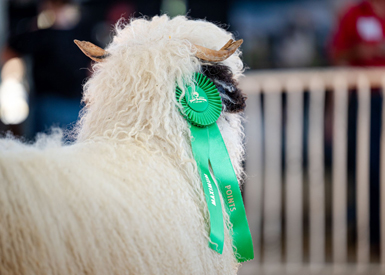 |
What is grading?
Each individual purebred is graded against the breed standard. The purebred is scored on appearance (overall structure & proportion, markings), conformation (legs & gait), and wool. The scoring scale changes depending upon the age of the purebred. The goal is three 4s for age 4-12 months, three 5s for age 12-24 months, three 6s for age 24-36 months. Rams or ewes over 36 months of age are no longer eligible for grading. Upon grading, if the quality of the sheep receives the maximum points, this is referred to as “Maximum Points”. If one point was deducted, this is referred to as “-1”. Rams are graded more strictly than ewes. Only purebreds are eligible for grading.
Why have purebreds graded?
Think of it as a “Good Housekeeping seal of approval”…in other words, an expert has evaluated and verified the quality. In this case, the sheep has been evaluated by a team of Swiss commissioned (trained & certified) graders/judges.
Why does it matter?
As more sheep are graded, the option of choosing graded animals for ram semen and live animals will become an easy choice to guarantee quality. If a breeder or buyer is not 100% confident in their ability to judge quality, or just wants confirmation of quality, the grading score is a trusted measure of quality. Breeders or buyers will seek “maximum points or -1” graded sheep or ram’s semen for purchase, confident of what they are getting.
What does it mean for the future?
Ultimately, this will improve the quality of Valais Blacknose sheep, as breeders can choose “maximum points or -1” ram semen, rams and ewes. In the future, as in other countries, different tiers of Valais Blacknose sheep quality will be recognized and buyers will pay accordingly.
What is the difference between grading sheep vs. showing sheep?
Grading evaluates the individual sheep against the breed standard. Grading is anonymous - the sheep are assigned a number & tagged, and no breeder/owner handles their own sheep during grading. Grading is done before the show. Not all sheep breeds/shows will grade.
Showing sheep is comparing sheep in the show ring on that particular day and placing the animals in order of their being closest to the breed standard. The breeder/owner will often handle or show their own sheep.
|
|
